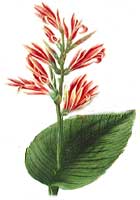
When I first moved into my current home and started working on putting in a garden, I found it overgrown with a plant unknown to me, which I started pulling out. I later learned it was
Lemon Balm or
Melissa officinalis and, thankfully, it all came back. Now I value it. Since then I have learned to find out what the “weeds” are before I pull them out. Consequently, there is very little I take out now. Lately, I found out that native grasses are hiding places for bees, so now hardly any grass gets taken out either. For the untrained eye, my garden might look like a weed patch with a few obviously cultivated places. To me, it is a habitat for bees, butterflies, birds and yes, even bugs, as well as where I grow my medicinal plants, flowers and vegetables. This year, I am experimenting with leaving the spearmint growing in the middle of tomato plants. It seems that I have no bugs on the tomatoes which may be because of the volatile oils in the spearmint. This is entirely unscientific, but as an aromatherapist, I know that the volatile oils in plants serve many functions, including protection and healing. So…. It follows that this may be what is occurring. I keep asking the tomatoes and they say they are happy. Huh? You talk to your plants? Of course. And they talk back? Yes, I can hear them in my head.
Now, back to
Lemon Balm. First off, any plant that has
officinalis in its
Latin name means it was part of the official pharmacopeia - that is, it was used in the practice of medicine.
This is interesting because it originally came from the Middle East and has been cultivated there for over 2000 years.
Ibn Sina, the 11th century medical genius, known in Europe as
Avicenna, prescribed lemon balm for melancholy and heart problems. It is a gentle and effective nerve tonic and it tastes delicious.*
It was brought by
Arab traders to Europe through Spain during the period we learned to call, the “Moorish occupation”, but in fact, saw the most peaceful and fruitful flowering of culture, science, literature and spirituality. It was when Judaism, Christianity and Islam were working together in Spain and North Africa and when so many advances were made in all fields of human endeavor. The 'Golden Age' as far as I’m concerned. But one of which we, in the west, know so little.
Some interesting points:
- In Germany, the famed alchemist,
Paracelsus called this herb the
'elixir of life' and used it in a compound called
Primum Ens Melissae, reputed to restore vigour and prolong life.
- Lemon balm is reported to increase energy in the system by helping to release energy blocks and stress. It is relaxing, yet stimulating. It acts as an anti-depressant.
- In Europe, lemon balm is used in salves for herpes simplex symptoms. There is a lot of research being done that shows that lemon balm prevents certain viruses from attaching to cells.
- It can be used as a homemade insect repellant because its oil contains citronellal. Crush a handful of leaves in your hand and rub them on exposed skin.
A delicious tea can be made from the leaves, fresh or dry.*
*Taken from
Natural Remedies of Arabia, by
Robert W. Lebling and
Donna PepperdineThe word 'melissa' is a
Greek word. In Greek mythology, Melissa was - a nymph and daughter of King Melisseus; she nursed the infant Zeus with goat milk on Mt. Ida; she taught humans how to use honey and her name comes from the Greek word for bee, melitta. Bees love the flowers that come late in the summer.
A great link to learn more is from
A Modern Herbal by Mrs. M. Grieve, at Botanical.com -
Melissa officinalis When growing lemon balm, you must use caution or it will take over. If you don't want it
everywhere, growing in a pot might help.
I got this recipe from a fellow blogger:
Melissa Cordial2 ½ tsp dried lemon balm
sliced and scraped peel of ¼ lemon
a pinch of coriander
a pinch of cinnamon
2 peppermint leaves
1 cup vodka
½ cup sugar syrup
Place all the ingredients in a bottle and steep 3 weeks. Shake the jar daily during the steeping period. Strain and filter into a dark bottle, adding more sugar to taste. Mature for 2 months.
Sugar Syrup also known as Simple Syrup
1 cup white granulated sugar and ½ cup water
Bring to a boil, and stir until all the sugar is dissolved and the mixture is clear. Always cool before adding to alcohol mixture.
 Wanted you to see the tincture and infused oil I made from the St. John's wort I harvested a month ago.
Wanted you to see the tincture and infused oil I made from the St. John's wort I harvested a month ago.




